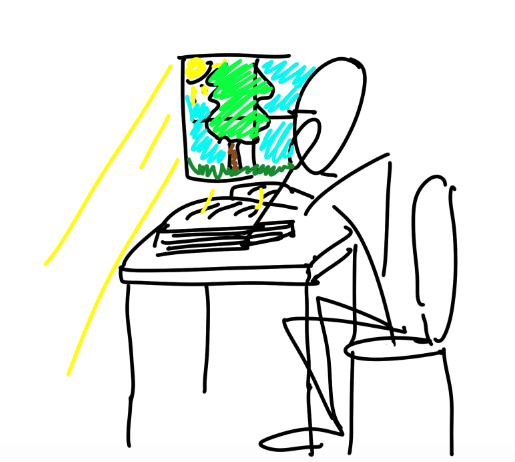Deliverables¶
Timeline¶
Mid-term presentation¶
Story telling script¶
Brainstorming scenes¶
Passive vs Active learning clarification: What if students were taught to actively practice science rather than passively absorbing information?

 Scenes of student performing traditional science class exercises such as reading a textbook and taking a test. The student reading the textbook is staring out the window where nature is beconing.
Scenes of student performing traditional science class exercises such as reading a textbook and taking a test. The student reading the textbook is staring out the window where nature is beconing.
Passive learning, such as reading a textbook, involves receiving information without actively engaging with it. This approach tends to be less engaging and may lead to lower retention rates because learners aren't actively processing or applying the information. Unfortunately, American traditional high school science education relies heavily on passive learning. However, this type of learning does not reflect the true practice of science.
Science is inherently an engaging activity. To truly understand scientific concepts, one must immerse themselves in the material, ask questions, and actively perform tests or experiments. Science is not merely about memorizing facts; it's about exploring the external world, making observations, forming hypotheses, and testing them through experimentation. In this sense, science shares similarities with art, which is a way of expressing the inner world. Both involve active exploration and experimentation, whether it's in the pursuit of understanding the external world through science or expressing one's inner thoughts and emotions through art.
Therefore, a shift towards more active learning approaches in science education can better reflect the true nature of scientific inquiry and lead to deeper understanding and appreciation of the subject.
Jar diversity = Biodiversity

I want to challenge the notion of adhering to a uniform aesthetic, particularly when it comes to using glass jars of the same size and shape. There are several reasons why embracing variety in the jars is not only beneficial but also reflective of biological principles.
Firstly, biology is inherently diverse and dynamic. Just as living organisms come in various shapes, sizes, and forms, using a variety of bottles mirrors the richness of biological diversity.
Secondly, the idea that academia must adhere to a sterile, uniform aesthetic is rooted in a specific Western ideology of science. While this approach has its merits, it's important to recognize that it's not the only valid perspective. Other cultural and philosophical traditions offer alternative ways of understanding and investigating the natural world.
Thirdly, considering that this project is designed for young adults, it's crucial to make science engaging and fun. By evoking the atmosphere of mysterious laboratories depicted in movies like Harry Potter, with their assortment of peculiar bottles, we can ignite curiosity and creativity in young minds. The unconventional shapes and sizes of the bottles may prompt exploration and imaginative thinking, fostering a deeper appreciation for science.
Moreover, using donated bottles from the school community promotes sustainability and community involvement. It emphasizes the principles of upcycling, reuse, and sustainable practices, demonstrating the collective effort to contribute to a meaningful project.
Finally, the insistence on uniformity in the jars can be likened to monocultures in agriculture, which often lead to ecological imbalances. Embracing biodiversity, both in nature and in our educational practices, encourages open-mindedness and a holistic approach to understanding the world around us.
In summary, by embracing variety in the jars used for this project, we not only honor the principles of biology and sustainability but also foster creativity, engagement, and a deeper appreciation for the natural world.
Storytelling sketch¶
Title of the video | Living BioLibrary: Student-Driven Initiatives in Biomaterials, Biochromes, and Bioelectronics. Location | Wildwood School/Outside
Scene 1.
Student is reading a textbook, looking bored and unengaged. The room feels stagnant, lacking any energy or vitality. The student looks out the window where nature is bright, vibrant, and beckoning.
Sunlight streams in, casting a warm glow across the room. The camera shifts to the window, revealing a scene of nature in full bloom.
Text: “What if students discovered that science is as creative a field as art?”
Scene 2.
Nature scene shifts to images of jars displayed amongst greenery. Students find jars outside, pick them up, and begin opening them and exploring the contents.
Scene 3.
Scene shifts to the classroom with the same students exploring the contents of jars, brainstorming ideas and working together. Students use the QR code on the jars to find out more information on the contents including procedure used.
Multiple clips of students performing a variety of experiments (extracting natural dyes, subculturing fungi, making bioplastics, using the 3D printer, etc).
Clips of students taking notes, writing procedures, and adding information to their websites.
Clips of students' final projects and engaging with visitors at the final culminating event of Science Night.
Scene 4. Students begin placing their samples into glass jars. They place the jars onto the shelf with all of the other jars. Vines start growing over the jars and they become immersed in nature once again.